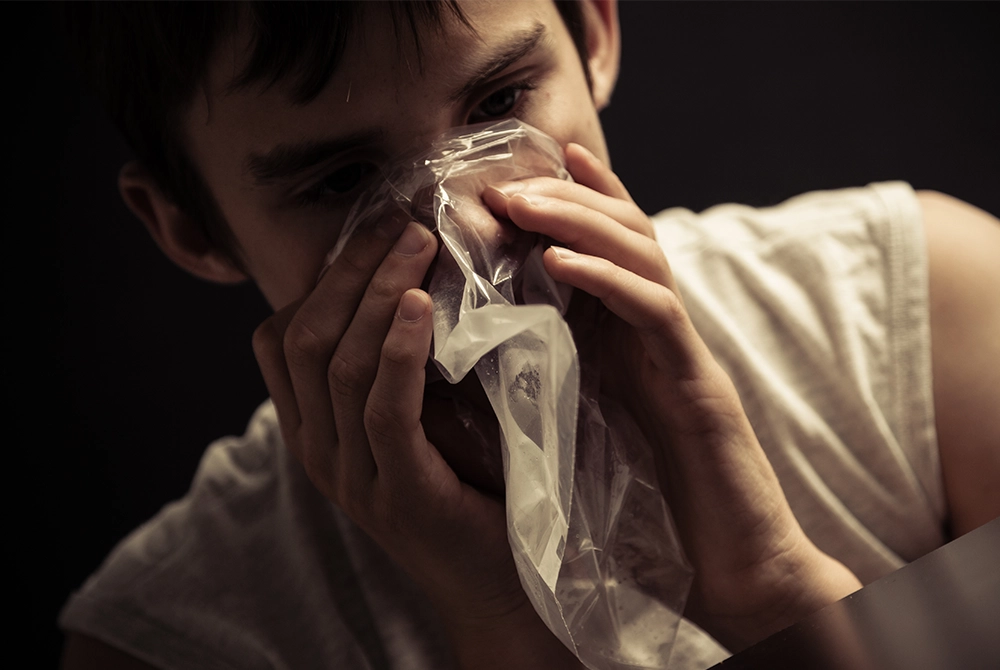Addiction

What are inhalants?
Inhalants are chemical or gaseous substances that produce mind-altering effects when inhaled. Most of them are products used in everyday life, so they are not typically classified as drugs. They can be extremely dangerous because they are generally not intended for human consumption, and they can cause permanent damage and death.

Addiction inhalants that are used as drugs fall into four broad categories:
- Volatile solvents: industrial or household products like paint thinners, gasoline and cleaning products, and office or art supplies like glue and felt-tip markers
- Aerosols: hairspray, deodorant, spray paints, aerosol cleaning products
- Gases: household or commercial products like butane lighters, propane tanks and “whippets” (whipped cream aerosol cans), and medical anaesthetics like nitrous oxide (“laughing gas”), ether and chloroform
- Nitrites: substances like amyl nitrite and cyclohexyl nitrite (“poppers”), which are usually sold as sexual enhancement products
Addiction Inhalants are taken in a number of ways, the most common of which are the following:
- Huffing: inhalation via a chemical-soaked rag that is held to the face
- Sniffing: inhalation directly from the product or a vessel containing the product
- Bagging: inhalation via a plastic bag that has been sprayed with vapours and placed over the head
Are inhalants addictive?
Inhalants have the same potential as other substances to become addictive. Their effects are felt quickly, and regular users often have intense cravings and physical withdrawal symptoms between uses.
When inhalants are breathed in, they are absorbed by the lungs and quickly travel to the brain in the user’s blood. This results in an immediate feeling of intoxication that lasts anywhere from a few minutes to almost an hour. While some use of inhalants is occasional and experimental, there are people who use them regularly, repeatedly taking breaths of the substance to sustain the high for several hours.
How dangerous are inhalants?
Inhalants are extremely dangerous to all users. Many of them contain chemicals that are regarded as poisonous to humans, and their effects can be severe, unpredictable and permanent. According to the Centre for Addiction and Mental Health, children between the ages of ten and sixteen are more susceptible than other people to inhalants abuse. Symptoms and effects include the following:
- Sniffing inhalants reduces inhibitions and makes users behave in a reckless manner, without regard for safety.
- Bagging – the practice of inhaling substances from a plastic bag – can lead to suffocation.
- Sniffing can result in an erratic heartbeat, which in turn can lead to heart failure.
- Long-term use of inhalants can result in permanent damage to many organs, including the liver, kidneys, lungs, heart and brain.
- Inhalants can lead to a loss of coordination and muscle control.
- Some inhalants can weaken the immune system, making users susceptible to illness.
- Use of solvents during pregnancy can lead to pregnancy complications, birth defects or stillbirth.
Inhalants addiction treatment
Addiction Rehab Toronto is an inpatient facility in Toronto that provides treatment for individuals with an addiction to inhalants. Using a holistic approach, we guide our clients through medically supervised withdrawal and recovery, and we give them the tools to repair relationships and lead positive, abstinence-based lives.
Treatment plans are customized for each individual, and incorporate elements from the following:
- Individual counselling
- Family and group counselling
- Cognitive behavioural therapy
- Yoga and meditation therapy
- Life management courses
- Physical fitness and nutrition
- Recreational activities
Continued support is provided in the form of a free aftercare program, after the client’s time in the inpatient program has come to an end. To learn more, please call us at 1-855-787-2424 or email info@addictionrehabtoronto.ca.











